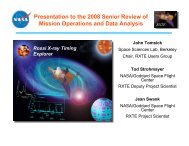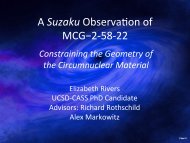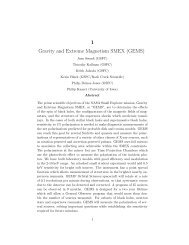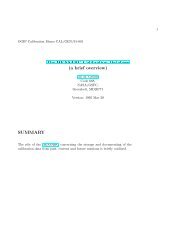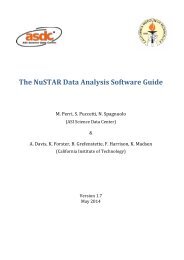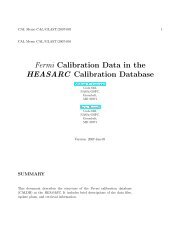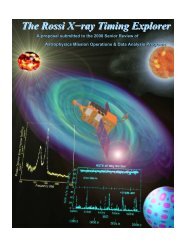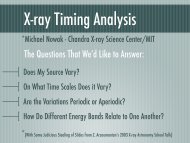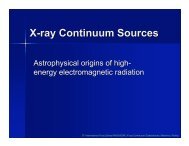The Why & How of X-Ray Timing - HEASARC - NASA
The Why & How of X-Ray Timing - HEASARC - NASA
The Why & How of X-Ray Timing - HEASARC - NASA
- No tags were found...
Create successful ePaper yourself
Turn your PDF publications into a flip-book with our unique Google optimized e-Paper software.
<strong>The</strong> <strong>Why</strong> & <strong>How</strong> <strong>of</strong>X-<strong>Ray</strong> <strong>Timing</strong>Z. Arzoumanian(USRA/<strong>NASA</strong>-GSFC)with thanks to C. Markwardt•<strong>Why</strong> should I be interested?•What are the tools?•What should I do?
Typical Sources <strong>of</strong> X-<strong>Ray</strong> Variability• Isolated pulsars (ms–10 s)• X-ray binary systems– Accreting pulsars (ms–10s s)– Eclipses (10s min–days)– Accretion disks (~ms–years)• Flaring stars & X-ray bursts• Probably not supernovaremnants, clusters, or the ISM• But there could be variableserendipitous sources in thefield, especially in Chandraand XMM observationsIn short, stellar-sized objects (& super-massive black holes?)
<strong>Why</strong> should I be interested?• Rotation <strong>of</strong> stellar bodies– pulsation period– stability <strong>of</strong> rotation• Accretion phenomena– broadband variability– “quasiperiodic” oscillations (QPOs)– bursts & “superbursts”• Binary orbits– orbital period– sizes <strong>of</strong> emission regionsand occulting objects– orbital evolution
Rotational modulation: PulsarsCrab pulsar
Sco X-1Accretion Science: QPOs fromNeutron Star BinariesExcludedkHz QPO maximum frequency constrainsNS equations <strong>of</strong> state
Questions that timing analysis should address• Does the X-ray intensityvary with time?• Any correlated changes in spectralproperties or emissions at otherwavelengths?• On what timescales?– Periodic or aperiodic?What frequency?– <strong>How</strong> coherent? (Qvalue)• Amplitude <strong>of</strong> variability– (Fractional) RMS?• Any variation with time<strong>of</strong> these parameters?
BasicsA light curve (for each source in the FOV) is a good first step• Sampling interval∆t and frequencyf samp = 1/∆t• Nyquist frequency,f Nyq = 1 / 2 f samp ,is the highest signalfrequency that canbe accuratelyrecovered• Basic variability measure,variance: σ 2 = – 2σ ≡ Root Mean Square
Fourier AnalysisAnswers the question: how is the variability <strong>of</strong> a source distributed infrequency?• Long-timescalevariations appear inlow-frequencyspectral bins, shorttimescalevariationsin high-frequencybins• If time-domainsignal varies withnon-constantfrequency, spectralresponse is smearedover several bins
A quasiperiodicoscillation is a “sloppy”oscillation—can be dueto:• intrinsic frequencyvariations• finite lifetime• amplitude modulationQ-value = f o /ΔfWhat is a QPO?
Fourier Transform & FFT• Given a light curve {x}with N samples, Fouriercoefficients are:a j = ∑ k x k exp(2πijk/N),[ j = – N / 2 ,…,0, N / 2 –1],usually computed with aFast Fourier Transform(FFT) algorithm, e.g., withthe powspec tool.• Power density spectrum(PDS):P j = 2 ⁄ Nph|a j | 2[Leahy normalization]Use Pj / (fractionalRMS normalization) toplot ( rms / mean ) 2 Hz –1 , <strong>of</strong>tendisplayed and rebinned ina log-log plot.
Estimating Variability from observations• Find “area” A under curvein power spectrum,A = ∫ P dν ≈ ∑ j P j ∆ν,where P j are the PDSvalues, and ∆ν = 1 / T is theNyquist spacing.• Fractional RMS isr = √ A / • For coherent pulsations,f p = √ 2(P–2) / is the pulsed fraction, i.e.,(peak–mean)/mean
Estimating Variability for ProposalsTo estimate amplitude <strong>of</strong> variations, or exposure time, fora desired significance level…• Broadband noise:r 2 = 2nσ √ ∆ν / I√ Twherer —RMS fractionn σ —number <strong>of</strong> “sigma” <strong>of</strong>statistical significancedemanded∆ν —frequency bandwidth(e.g., width <strong>of</strong> QPO)I —count rateT —exposure time• Coherent pulsations:• Example:f p = 4 nσ / I TX-ray binary, 0–10 Hz, 3σdetection, 5 ct/s source,10 ks exposure 3.8% threshold RMS
Power Spectrum Statistics• Any form <strong>of</strong> noise willcontribute to the PDS,including Poisson(counting) noise• Distributed as χ 2 with 2degrees <strong>of</strong> freedom (d.o.f.)for the Leahy normalization• Good—Hypothesis testingused in, e.g., spectroscopyalso works for a PDS• Bad —mean value is 2,variance is 4! Typical noise measurementis 2±2• Adding more lightcurvepoints won’t help: makesmore finely spacedfrequencies
Statistics: Solutions• Average adjacentfrequency bins• Divide up data intosegments, make powerspectra, average them(essentially the samething)• Averaging M bins togetherresults in noise distributedas χ 2 /M with 2M d.o.f. for hypothesis testing,still chi-squared, but withmore d.o.f.• <strong>How</strong>ever, in detecting asource, you examine manyFourier bins, perhaps all<strong>of</strong> them. Thus, thesignificance must bereduced by the number <strong>of</strong>trials. Confidence isC = 1 – N bins × Prob(MP j ,2M),where N bins is the number<strong>of</strong> PDS bins (i.e., trials),and Prob(χ 2 ,ν) is thehypothesis test.
Tips• Pulsar (coherent pulsation) searches are mostsensitive when no rebinning is done• QPO searches need to be done with multiplerebinning scales• Beware <strong>of</strong> signals introduced by– instrument, e.g., CCD read time– dead time– orbit <strong>of</strong> spacecraft– rotation period <strong>of</strong> Earth (and harmonics)
What To Do• Step 1. Create light curves for each source in yourfield <strong>of</strong> view inspect for features, e.g., eclipses.Usually, this is enough to know whether toproceed with more detailed analysis, but you can’talways see variability by eye!• Step 2. Power spectrum. Run powspec orequivalent and search for peaks. A good startingpoint, e.g., for RXTE, is to use FFT lengths <strong>of</strong> ~500 s.
SAX J1808: <strong>The</strong> First AccretingMillisecond PulsarLightcurveResidualsPDS
Step 3. Pulsar or eclipses found?Refine timing analysis to boost signal-to-noise.• Barycenter the data: corrects to arrival times at solar system’s center <strong>of</strong> mass(tools: fxbary/axbary)• Refined timing– Epoch folding (efold)– <strong>Ray</strong>leigh statistic (Z 2 )– Arrival time analysis(Princeton TEMPO?)• Hint: best to do timing analysis (e.g., epoch folding especially) on segments <strong>of</strong>data if they span a long time baseline, rather than all at once.
Step 3. Broadband feature(s) found?Refined analysis best done interactively (IDL? MatLab?).• Plot PDS• Use χ 2 hypothesis testing to derive significance <strong>of</strong> features• Rebin PDS as necessary to optimize significance• If detected with good significance, fit to simple-tointegratemodel(s), e.g., gaussian or broken power-law• Compute RMS
Rebinning to find a QPO: 4U1728–34• To detect a weak QPO buried in a noisy spectrum,finding the right frequency resolution is essential!
Suggested Reading• van der Klis, M. 1989,Fourier Techniques in X-ray <strong>Timing</strong>, in <strong>Timing</strong>Neutron Stars, NATO ASI282, Ögelman & van denHeuvel eds., Kluwer• Press et al., NumericalRecipes– power spectrum basics– Lomb-Scargle periodogram• Leahy et al. 1983, ApJ266, 160– FFTs; power spectra;statistics; pulsars• Leahy et al. 1983, ApJ272, 256– epoch folding; Z 2• Vaughan et al. 1994, ApJ435, 362– noise statistics



